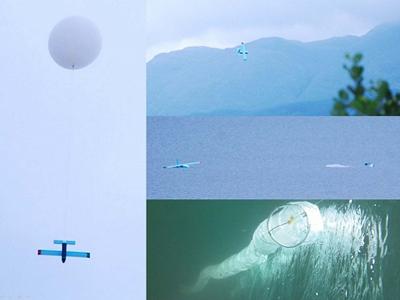Southampton Autonomous Systems researchers win £171K as part of a NERC Technology Proof of Concept study

Fresh WAys of Targeting and Employing Robotic Systems (FreshWATERS)
Dr András Sóbester and Dr Eleanor Frajka-Williams have been awarded £171k as part of a NERC Technology Proof of Concept study titled FreshWATERS (Fresh WAys of Targeting and Employing Robotic Systems).
The project will investigate the use of high altitude gas balloons as a means of delivering oceanographic instrument packages to remote locations on the surface of the ocean that are hard to access by other means. The title hints at one such location to be considered: the Labrador Sea, where the fresh waters resulting from melting Greenland ice mix with the salt waters of the North Atlantic.
Ocean drifters are typically deployed via crewed vessels. The size and sophistication of these depends on the scale of the research, the distances involved, the size of the area to be covered, how long it will take and the number of drifters deployed. The cost can be prohibitive and such limitations affect oceanography’s ability to answer a number of important science questions. For example, freshwater typically forms a shallow layer over the surface of the ocean, making surface currents the most valuable measurement. Ship-based sampling cannot be carried out over a full seasonal cycle due to the expense of hiring a ship for that long and also because and near surface measurements may be contaminated by the ship itself. Surface drifters are ideal for measuring surface currents, but if they rely on ships for deployment, they will suffer from the limitations outlined above.
The FreshWaters solution exploits the simplicity and low cost of lighter-than-air systems by using gas balloons launched from (typically) land-based locations to deliver the drifters to target areas, including deployment to remote and harsh environments like the Labrador Sea, without the aid of a global class research ship.
At the heart of the FreshWATERS concept of operations lies a flight planning system which the research team will develop. This is, effectively, an optimization algorithm, which, given the payload mass (that is, the mass of the drifter), the forecast wind field, and the available balloon types and sizes, computes the trajectory that minimizes the distance between the target and the predicted landing site. The optimization is performed via a variable vector comprising the amount of lifting gas, the size and type of balloon (equal pressure or superpressure), the launch date and time and the latitude and longitude of the launch site.
Apply for a post with this project
The project will be seeking to appoint a numerical modelling expert and an electronic/mechanical/aerospace engineer.
Contact András Sóbester A.SOBESTER@soton.ac.uk for information on these opportunities